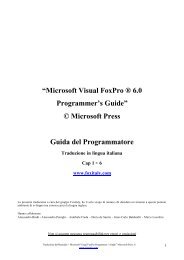Users Guide Visual FoxPro®" di Microsoft
Users Guide Visual FoxPro®" di Microsoft
Users Guide Visual FoxPro®" di Microsoft
You also want an ePaper? Increase the reach of your titles
YUMPU automatically turns print PDFs into web optimized ePapers that Google loves.
Per aggiungere l’importanza <strong>di</strong> un or<strong>di</strong>namento in base ai campi. Utilizzare il tasto a sinistra del campo e trascinatelo<br />
nella posizione desiderata nella finestra Ordering criteria.<br />
Potete or<strong>di</strong>nare i dati in or<strong>di</strong>ne ascendente e <strong>di</strong>scendente impostando il tasto nell’area opzioni or<strong>di</strong>namento ( Order<br />
option ). Ogni campo or<strong>di</strong>namento appare nella finestra Output Field nella scheda Filter con una freccia rivolta verso<br />
l’alto o verso il basso che in<strong>di</strong>ca se l’or<strong>di</strong>namento deve essere fatto in senso ascendente o <strong>di</strong>scendente.<br />
Raggruppare il risultato <strong>di</strong> una query<br />
Il raggruppamento fonde o raccoglie record simili in un record in modo da consentire calcoli basati su gruppi <strong>di</strong> record.<br />
Ad esempio, potreste voler trovare la somma <strong>di</strong> tutti gli <strong>di</strong> una regione specifica. Al posto <strong>di</strong> controllare tutti i records<br />
singolarmente, potete raggruppare tutti i records <strong>di</strong> una stessa regione in un solo record, e ottenere la somma <strong>di</strong> tutti gli<br />
or<strong>di</strong>ni <strong>di</strong> quella regione.<br />
Per controllare il modo con cui i records vengono raggruppati, utilizzate la scheda Grup By Query Designer.<br />
To control how records are grouped, use the Group By tab in the Query Designer. Il raggruppamento è molto più utile<br />
quando viene utilizzata in unione con la funzione <strong>di</strong> somma come SUM, COUNT, AVG e così via.<br />
Ad esempio, supponiamo <strong>di</strong> volere il totale degli importi <strong>di</strong> ogni co<strong>di</strong>ce cliente nella tabella clienti. Avete bisogno <strong>di</strong><br />
raggruppare tutti i records degli or<strong>di</strong>ni per ogni co<strong>di</strong>ce cliente in un solo record, e quin<strong>di</strong> trovare la somma totale degli<br />
or<strong>di</strong>ni.<br />
Prima <strong>di</strong> tutto dovete usare la scheda Fields per aggiungere l’espressione SUM(Or<strong>di</strong>ni.or<strong>di</strong>ne_netto) al risultato della<br />
query, quin<strong>di</strong> raggruppate i risultati in base al co<strong>di</strong>ce cliente. Il risultato mostra il totale netto degli or<strong>di</strong>ni <strong>di</strong> ogni<br />
cliente.<br />
Impostare le opzioni <strong>di</strong> Group By




